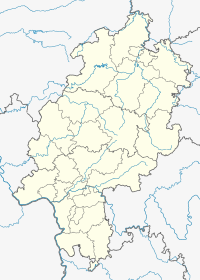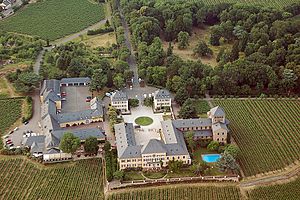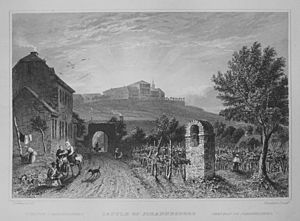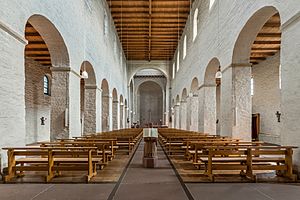Schloss Johannisberg facts for kids
Quick facts for kids Schloss Johannisberg |
|
|---|---|
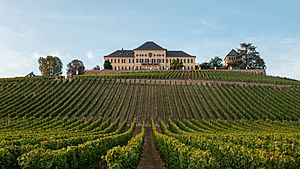
Schloss Johannisberg within its vineyards
|
|
| Location | Johannisberg (Geisenheim), Hesse, Germany |
| Founded | 1100: 919 years ago |
| Parent company | Dr. Oetker |
| Known for | Schloss Johannisberg Riesling |
| Varietal | Riesling |
| Distribution | international |
| Tasting | open to the public |
Schloss Johannisberg is a famous castle and winery in Germany. It is located in the village of Johannisberg, near Wiesbaden in the Rheingau wine region. This place has been making wine for over 900 years! It is especially known for being the first to "discover" late harvest wine. The castle is also a popular spot for the Rheingau Musik Festival.
Contents
History of Schloss Johannisberg
The area where Schloss Johannisberg stands has been important for winemaking since the Middle Ages. Around the year 1100, a group of Benedictine monks finished building a monastery there. They believed it was one of the best places to grow grapevines.
About 30 years later, the monks built a church called a Romanesque basilica. They named it after John the Baptist, and the hill became known as Johannisberg, meaning "John's mountain." Sadly, the monastery was destroyed in 1525 during the German Peasants' War.
In 1716, a leader named Konstantin von Buttlar bought the estate. He started building the beautiful baroque palace you see today. In 1720, he planted Riesling grapevines. This made Schloss Johannisberg the oldest Riesling vineyard in the world!
The estate changed hands a few times during the wars led by Napoleon. In 1816, the Holy Roman Emperor gave it to a famous Austrian leader, Prince von Metternich.
In 1942, during World War II, the Schloss was bombed. Most of it was destroyed. By the mid-1960s, it was mostly rebuilt by Paul Alfons von Metternich-Winneburg and his wife Tatiana. In 1974, the estate was sold to the German Oetker family. Today, there are about 35 hectares (86 acres) of vineyards.
The Story of Late Harvest Wines
Schloss Johannisberg is famous for its "late harvest" wines. The story goes that one year, a messenger was 14 days late bringing permission to pick the grapes. This delay meant the grapes stayed on the vines much longer than usual.
During this extra time, a special kind of mold, called "noble rot" (Botrytis cinerea), grew on the grapes. This mold makes the grapes shrivel and become very sweet. When the winemakers finally picked these "rotted" grapes, they made a surprisingly high-quality wine!
In 1775, Schloss Johannisberg made the first Spätlese Riesling. This means "late harvest." Later, they made an Auslese wine in 1787 and an Eiswein (ice wine) in 1858. These are all types of sweet wines made from very ripe grapes.
Historically, the estate used different colored seals on their wine bottles. Each color showed how ripe the grapes were when they were picked. These colors helped create the system for German wine classification in 1971.
| Gelblack | Yellow | Qualitätswein (Quality wine) |
| Rotlack | Red | Kabinett (Lighter, fine wine) |
| Grünlack | Green | Spätlese (Late harvest) |
| Silberlack | Silver | "Erstes Gewächs" (First growth, top quality) |
| Rosalack | Pink | Auslese (Selected harvest, sweeter) |
| Rosa-Goldlack | Pink-gold | Beerenauslese (Selected berry harvest, very sweet) |
| Goldlack | Gold | Trockenbeerenauslese (Dry berry selection, extremely sweet) |
| Blaulack | Blue | Eiswein (Ice wine) |
Schloss Johannisberg is so special that it is a single vineyard designation. This means it doesn't need to show a village name on its wine labels. You will just see Schloß Johannisberger on the bottle.
The Soil and Grapes
The 35 hectares of vineyards have a top layer of loam and loess soil. This sits on top of a type of rock called Taunus quartzite. The soil is quite stony and gravelly. This helps it hold the sun's warmth during the day. It also helps keep the temperature steady for the grapevines.
Visiting Schloss Johannisberg
You can visit the estate and take guided tours. They often include wine tastings. There is also a wine bar and a shop. The Schloss hosts many special events throughout the year.
The Basilica Church
The church, called the Basilika, was first built for the Benedictine monastery. It was named after St. Johannes (St. John the Baptist). After being destroyed in World War II, it was rebuilt in the Romanesque style. Today, it serves as the Catholic church for the village of Johannisberg. It is also used for concerts, including performances for the Rheingau Musik Festival.
A Place for Music
The Ostflügel (East Wing) of the castle was rebuilt after the war. It was first used as a tennis court. However, Princess Tatiana von Metternich-Winneburg, who helped start the Rheingau Musik Festival, turned it into a concert hall.
Many concerts and music performances happen here every year. After her husband passed away, the hall was named "Fürst-von-Metternich-Saal" in his honor. Famous musicians, like the Spanish flamenco guitarist Paco de Lucía, have performed here.
Images for kids
See also
 In Spanish: Schloss Johannisberg para niños
In Spanish: Schloss Johannisberg para niños


